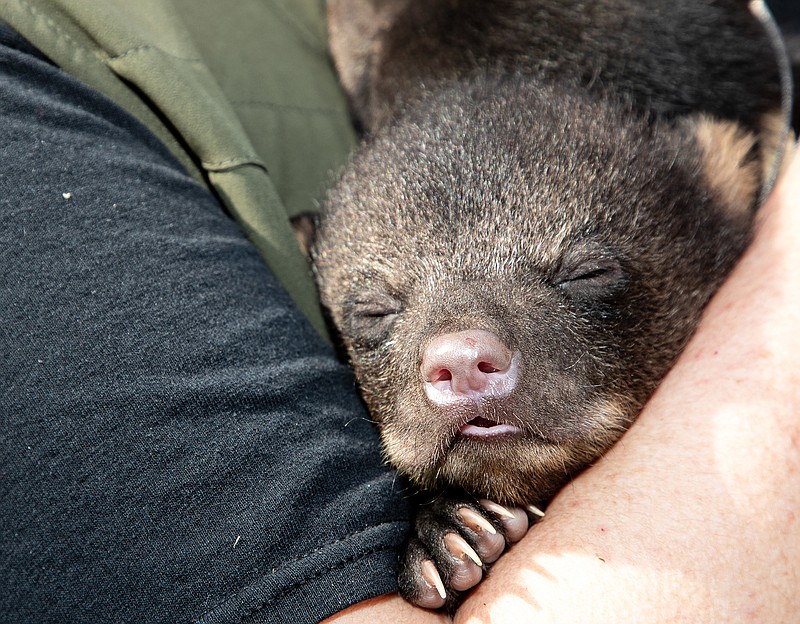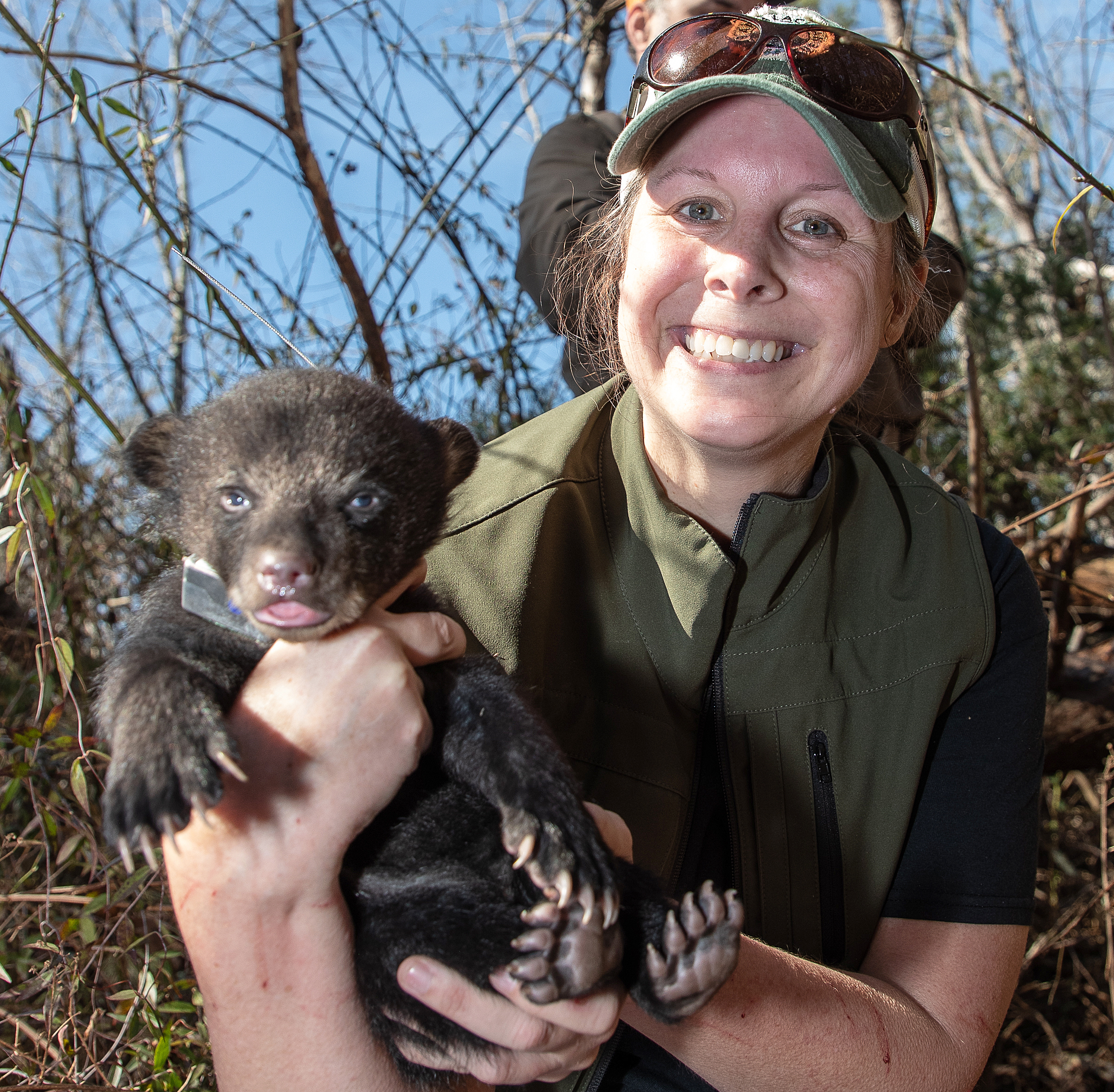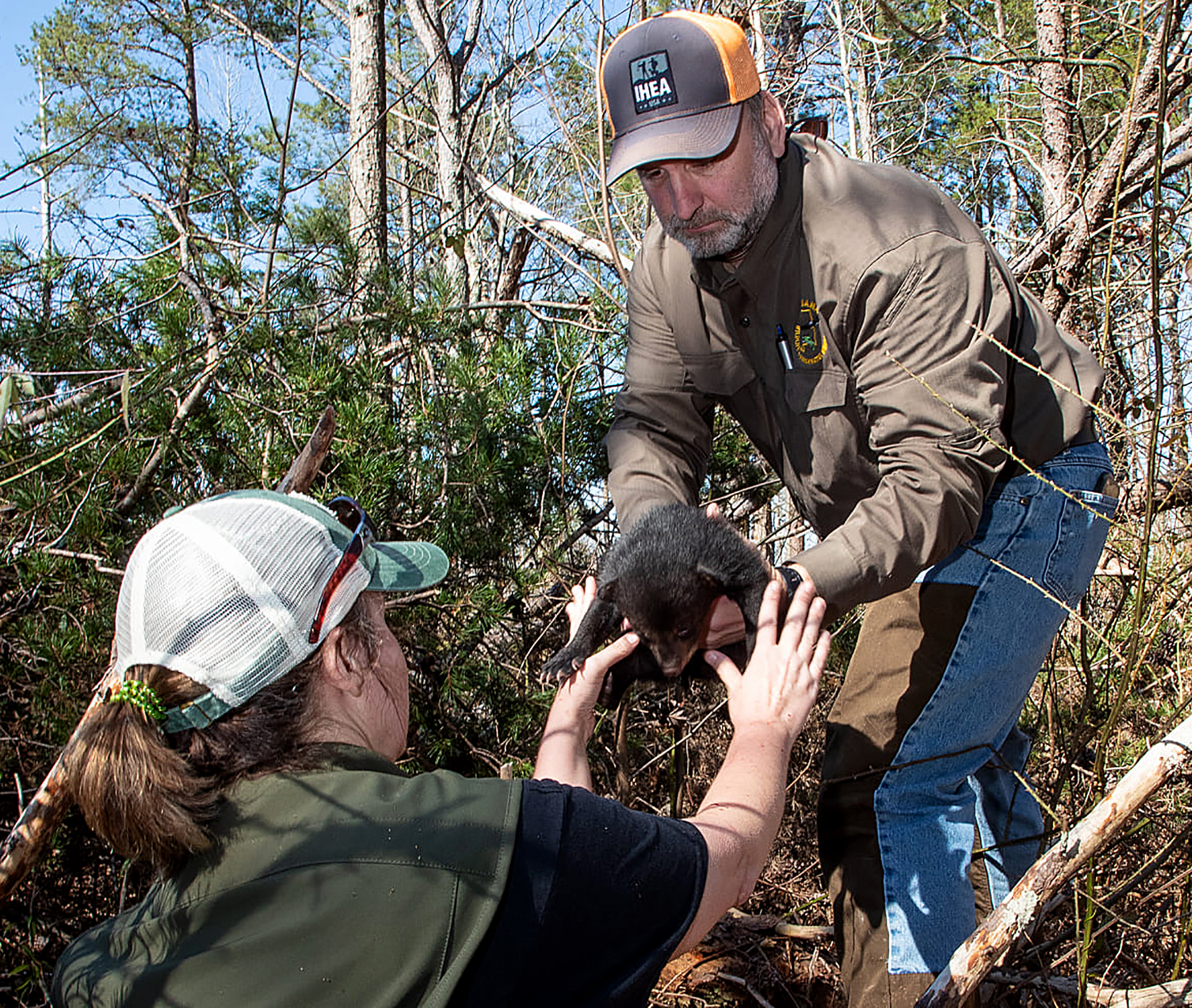A trio of black bear cubs born in the Mentone, Alabama, area could help researchers understand more about how they live and move as they grow into adults.
The Northeast Alabama population of black bears is doing very well and growing, Alabama Department of Conservation and Natural Resources state wildlife grants coordinator Traci Wood said Tuesday in an email.
"We are seeing that they are producing large litters, usually of two or three, and the cubs are very healthy and recruiting into the population," Wood said.
The three cubs were among nearly 20 recently collared by a team of biologists and researchers working on a study funded by state wildlife grants to monitor the black bear populations in Alabama, according to state officials. In its fourth year, the study takes a look at cub survival and den habitat.
The cubs' mother was collared last summer along with a number of other black bear sows, Wood said.
"All sows and yearlings are trapped and collared during the summer season and fitted with a GPS collar," she said. "This gives us the location of the bears and where they are moving. It also tells us where the sows den during the winter. This is how we know the den location of potential litters."
(READ MORE: Tennessee, Georgia wildlife officials warn of spring black bears on the move)
The collared cubs will provide the study an estimate of black bear cub survival and what factors threaten them. The collars expand with the cubs as they grow. When they reach 6 to 9 months old, the collar will fall off, she said.
REPORT BEAR SIGHTINGS
To report the sighting of a black bear to the Alabama Department of Conservation and Natural Resources, go to bit.ly/ALAbear to fill out a bear sighting form.To report a sighting by phone in Northeast Alabama, contact the department’s District 2 office in Jacksonville at 256-435-5422. Officials welcome reports of black bear sightings in Northwest Georgia because they could be part-time residents of Alabama.
"We want to observe this time period with cubs because their survival is tough until they get to this age," she said. "What we are seeing now is positive, with a good percentage of cubs surviving."
Along with the collars, captured cubs also got an implanted passive integrated transponder or PIT tag.
"So, if we trap that animal later, the PIT tag will identify it as a cub we had previously collared," she said.
When the collared cubs become adults and are collared again, the research team can collect valuable information about bear habits and their habitat over time.
"It tells us where they are going, if they're having cubs in the future," Wood said. "Hopefully, it's a long-term look at the life ecology of a bear from when it's born to its reproductive age."
In Alabama, the black bear is a species of highest conservation concern with no open hunting season.
Shooting at a black bear in Alabama is a misdemeanor punishable on a conviction by a $2,000-$5,000 fine, depending on the number of offenses, loss of hunting and fishing license privileges for three years and up to a year in jail, Alabama Wildlife and Freshwater Fisheries Assistant Chief Enforcement Officer Jonathan Stone said Tuesday in a telephone interview.
A vehicle, weapons or other equipment used to illegally hunt bears can also be confiscated, Stone said.
The black bear population in Northeast Alabama grabbed wildlife officials' attention back in 2011 after a 230-pound male black bear was killed by a car on Alabama Highway 35 and others were sighted in the Little River Canyon National Preserve in DeKalb County. Those bear sightings were followed by another bear killed on Alabama Highway 9 between Centre and Piedmont in 2012, the Chattanooga Times Free Press previously reported.
BEAR FACTS
— Black bears can be found across most of North America. Black bear habitat varies from the lowlands of Florida to the mountains, deserts and subarctic tundra. Black bears can be found in and adjacent to metropolitan areas.— Colors: Black, brown, blond, rust or cinnamon. Rare colors are white and blue.— Size: Adults measure about 3 feet at the shoulder and 5 to 6 feet when standing.— Weight: Adults weigh 125-425 pounds or more. Some Tennessee bears can weigh as much as 500 pounds.— Life Span: Approximately 20 years.— Eyesight: Similar to humans.— Sense of Smell: Excellent, can span miles.— Attributes: Very agile. Climb trees well. Good swimmers, and can run as fast as 35 mph.— A black bear’s diet can include acorns, berries, insects, vegetation, fish and other live prey and carrion. They mate during May and early June. They hibernate between November and April when food is scarce, though this may vary. Healthy mothers produce one to three cubs.Source: www.bebearaware.org
The new bear activity in the upper portion of the state triggered an Auburn University study seeking data on bear populations in the 14,000-acre national preserve.
Historically in Alabama, a small population of black bears has long existed in Mobile and Washington counties in the south end of the state, officials said. Baldwin, Covington and Escambia counties on the Florida border host another population of bears.
In Northeast Alabama near Chattanooga, bears migrating from Northwest Georgia have established a small but viable population in DeKalb, Cherokee and Etowah counties, officials said. The two populations are genetically different, though their appearance is very similar.
(READ MORE: Black bears on the rise in Northeast Alabama)
Wood studies the animals at opposite ends of the state, and they represent two different species of black bears, she said. The species in Northeast Alabama is of mostly Georgia descent, she said.
After the three bear cubs' mother was collared last summer, along with a number of others, wildlife officials started checking their dens, Wood said.
"Nine dens were checked this den season, with 18 cubs collared in Northeast Alabama," she said, noting dens on the northern end of the state must be checked in the first weeks of March to avoid missing the baby bears.
(READ MORE: Study seeks genetic background of bears)
"It is toward the end of March when mom leaves the den with cubs, either moving them to a safer area, or an area with a better food source," Wood said.
The collars also tell researchers if a cub dies.
"We have not had any mortality signals so far," she said. "We only encountered one deceased cub last month during a den check."
That cub was sent for a necropsy to attempt to determine the cause of death, she said.
The state line means nothing to the bears, but the females are calling Alabama home while young male bears are crossing the state line, Wood said.
"Preliminary data is showing that yearling males are mostly roaming to Georgia," she said. A yearling is about 18 months old. "Females are staying in Alabama, which we are happy about, because those females will contribute to Alabama's population."
Yearlings in the study will have ear tags, according to officials, and some could be fitted with a GPS collar, too.
Wood said wildlife officials want to hear about black bear sightings.
"We appreciate reports from not only Alabama citizens, but Georgia citizens as well," Wood said.
Wood also reminds people that black bears across the region are becoming active. Young male bears will be seeking new territory soon, and people should avoid leaving anything out that could attract bears and should never purposefully feed them, officials say.
Contact Ben Benton at bbenton@timesfreepress.com or 423-757-6569. Follow him on Twitter @BenBenton.
DON’T FEED THE BEARS
— If you see a bear in your yard, try to look large and make a lot of noise, back slowly away.— Never approach or follow a bear to take photos.— Do not purposefully feed bears.— Remove all attractants from your yard including bird feeders, uneaten pet food and ripe fruits or garden vegetables.— Store grills in a garage or outbuilding.— Store trash and recycling in bear-proof containers.— Do not feed birds between April and January, when bears are most active.— Remove uneaten pet food from outside areas or feed pets indoors.— Do not add greasy foods to your compost piles or compost in bear-proof containers.— Keep cooking grills clean and stored indoors when not in use.Source: Tennessee Wildlife Resources Agency


